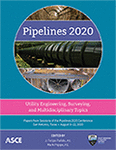Pipelines 2020
Optimize the Carbon Emissions of Prestressed Concrete Cylinder Pipe during the Life-Cycle
Publication: Pipelines 2020
ABSTRACT
As the world is moving to provide a better and cleaner environment for future generations, there is a critical need to reduce the environmental emissions footprints. Underground utility installation, especially in the development of residential communities in the urban area, is one of the largest construction projects across North America and, consequently, one primary source of emissions. This study focused on optimization of the CO2 emissions during the life cycle of one of the commonly used pipe materials: pre-stressed concrete cylinder pipe (PCCP). The study focused on a large-diameter 36-in. sewer pressure pipe operating at 100 psi internal pressure for 100-years life operation. The study compared and analyzed the CO2 emissions during fabrication, operation, and disposal phases for PCCP pipe, and give recommendations to how to reduce the CO2 emissions during the life-cycle of the pipe. The results of the study show that the CO2 has been reduced by 75% on the fabrication phase, 7% on the operation phase, and by 43% on the disposal phase of PCCP.
Get full access to this article
View all available purchase options and get full access to this chapter.
REFERENCES
Alsadi, A., Matthews, J., Matthews, E. (2019). Environmental Impact Assessment of the Fabrication of Pipe Rehabilitation. ASCE Journal of Pipeline System- Engineering and Practice, Accepted for Publication.
Alsadi, A., Matthews, J. (2019). Evaluation of Carbon Footprint of Pipeline Materials during Installation, Operation, and Disposal Phases. ASCE Journal of Pipeline System- Engineering and Practice, Accepted for Publication.
American Water Works Association (2014). Design prestressed concrete pressure pipe, steel cylinder type. ANSI/AWWA C301-14. Denver, CO: American Water Works Association.
Assard, L., Rosenberg, D., (2017). Epoxy Coating and Cement Mortar Lining. UCT Conference 2017.
Ashby. Michael and F. (2009). Materials and the Environment. Elsevier, London.
Bribián, I. Z., Capilla, A. V., & Usón, A. A. (2011). Life cycle assessment of building materials: Comparative analysis of energy and environmental impacts and evaluation of the eco-efficiency improvement potential. Building and environment, 46(5), 1133–1140.
Davidovits, J. (2015). False values on CO2 emission for geopolymer cement/concrete published in scientific papers.
Environmental Protection Agency EPA (2014). eGRID2014 US grid intensity.
Gao, W., Ariyama, T., Ojima, T., & Meier, A. (2001). Energy impacts of recycling disassembly material in residential buildings. Energy and Buildings, 33(6), 553–562.
Gupta, Ram S. (2008). Hydrology and Hydraulic Systems. Waveland Press, Illinois.
Hammond, G., and C. Jones. (2011). Inventory of Carbon and Energy (ICE), Version 2.0. Sustainable Energy Research Team. Department of Mechanical Engineering, University of Bath.
ImpEE, P. (2005). Recycling of plastics. Project University of Cambridge.
Lloyd, N., & Rangan, V. (2009). Geopolymer concrete-sustainable cementless concrete. In Proceedings of Tenth ACI International Conference (pp. 33–53). American Concrete Institute.
Matthews, J., Condit, W., Wensink, R., Lewis, G., & Sterling, R. (2012). Performance evaluation of innovative water main rehabilitation spray-on lining product in Somerville, NJ. US Environmental Protection Agency, Ofce. Res. & Development, National Risk Management Res. Laboratory.
Nath, P., Sarker, P. K., & Biswas, W. K. (2018). Effect of fly ash on the service life, carbon footprint and embodied energy of high strength concrete in the marine environment. Energy and Buildings, 158, 1694–1702.
Turner, L. K., & Collins, F. G. (2013). Carbon dioxide equivalent (CO2-e) emissions: A comparison between geopolymer and OPC cement concrete. Construction and Building Materials, 43, 125–130.
Information & Authors
Information
Published In
Pipelines 2020
Pages: 326 - 335
Editors: J. Felipe Pulido, OBG, Part of Ramboll and Mark Poppe, Brown and Caldwell
ISBN (Online): 978-0-7844-8321-3
Copyright
© 2020 American Society of Civil Engineers.
History
Published online: Aug 6, 2020
Published in print: Aug 6, 2020
Authors
Metrics & Citations
Metrics
Citations
Download citation
If you have the appropriate software installed, you can download article citation data to the citation manager of your choice. Simply select your manager software from the list below and click Download.
